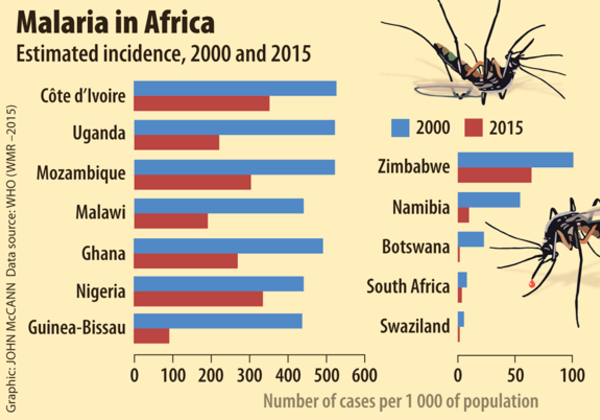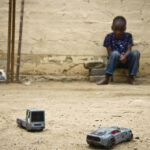Now the fight is on to eliminate the illness entirely – and save those still at the mercy of the mosquito.
In 15 years malaria deaths in Africa have more than halved – and deaths among children younger than five have declined by more than 70%.
This is according to the latest global malaria report published in December by the World Health Organisation (WHO).
Despite this, the health body warns that an African child still dies every two minutes from the mosquito-borne disease.
“This is monumental progress for a continent which has lost many lives and large amounts of money due to an illness which is largely preventable and certainly curable,” says Joy Phumaphi, the former health minister for Botswana and current head of the African Leaders Malaria Alliance (Alma).
The malaria parasite, Plasmodium, is carried by female mosquitoes of the genus Anopheles, according to the WHO. The mosquitoes pick up the parasite from infected people when they bite to get blood for their eggs. In this way the mosquitoes spread malaria, which is most common in Africa. The continent is responsible for 89% of all malaria cases and 91% of global deaths from the disease.
“So the global malaria agenda has shifted from control to elimination, because we see it’s possible and we know what can be gained,” says Phumaphi.
[WATCH] Mobile tech: A malaria-fighting secret weapon for Africa?
How much money can be saved by ending malaria in Africa?
According to a recent joint WHO and United Nations economic analysis published last year, eradicating malaria will save $2-trillion for the global economy in direct costs, which will help reduce poverty and hunger, and “promote productivity and increased employment in the workplace”.
“Those are just direct costs, for things like savings on hospital admissions and treatment, but the indirect savings are exponential,” Phumaphi says. In Africa, since 2000, progress in malaria control has saved the continent almost a billion dollars in direct costs and $12-billion indirectly, according to the WHO.
“If we eliminate we will save $34-billion. This is a huge amount of money for a continent that needs it most – these savings would then be available for other health and development issues, which we know are countless,” says Phumaphi.
Considering malaria has plagued us for thousands of years, is the 2030 goal realistic?
Phumaphi says there is a global consensus that we can only reach the target if malaria control efforts are “prioritised and attacked aggressively”, but even then the current strategies are not enough.
The WHO, in their recent report, projects that, if current interventions are sustained and gradually increased, the continent could see a 90% decline in illness and deaths related to malaria by 2030.
“But the challenge is to get every individual country to redouble efforts and be consistent about it – and even if this happens we will not eliminate malaria in the next 15 years,” says Phumaphi. “We definitely need new technology and innovations; we just won’t be able to eliminate malaria without it.”
Malaria is curable but still kills. Are the drugs effective?
Melanie Renshaw, chief technical adviser to Alma, says that one of the reasons malaria elimination is conceivable is as a result of improvements in treatment.
In 2000, resistance to the most common antimalarial drug, chloroquine, was widespread across Africa. This means the malaria parasite had evolved to the point where it was no longer killed by the only widely available medicine on the continent at the time.
“In some places, taking the medicine was like eating mints,” she says. “In the early 2000s came our treatment revolution: the artemisinin-based combination therapy.”
Renshaw says artemisinin combined with other antimalarials killed the parasite more quickly than existing therapies, had fewer side effects and was more “resistant to resistance” because more than one medicine attacked the parasite at the same time.
“In Asia we’re already seeing wide-scale resistance to artemisinin-based combination therapy, but Africa is in a unique position where the drug remains effective: they are faster-acting and clear the parasite from the body in three daily doses – it’s just a matter of getting it to the people who need it,” says Renshaw.

Testing comes before treatment. How important are diagnostics?
By the mid-2000s another “revolution” in the fight against malaria came in the form of rapid diagnostic tests, which, Renshaw explains, particularly benefited Africa because many countries’ health systems lacked the infrastructure to test individual specimens en masse.
“With this portable fingerprick test kit you could now quickly diagnose malaria at community level – not in hospitals in labs – giving many more communities access and decreasing the burden on centralised health facilities and budgets,” she says.
The UN-endorsed Roll Back Malaria initiative identified the need for new technologies for a malaria-free Africa by 2030, including “cutting-edge diagnostic technologies”. “Noninvasive methods that do not require blood being drawn are also desirable,” notes the organisation in a 2015 report about what investment is needed to reach the targets. (see ‘Innovation and technology will help to wipe out the illness’)
If a person is repeatedly cured and reinfected, shouldn’t the focus be on mosquitoes?
In 2007 the WHO issued a statement endorsing long-lasting insecticide-treated nets, which cover up to two people while they sleep, repelling mosquitoes.
Renshaw says these are essential in Africa where malaria-carrying mosquitoes bite people at night – usually after 10pm.
According to a 2014 study in the
Lancet medical journal, in Ethiopia, by last year, 86% of the population had these nets, which resulted in a 40% decline in malaria cases over a period of six years.
Indoor residual spraying, where insecticides are applied to walls, have also been “critical”, says Renshaw.
“These interventions in combination have revolutionised the malaria world and have made elimination by 2030 a goal, whereas before it would not even be considered as possible,” she says.
These strategies have made elimination a possibility, but are they enough?
Renshaw says, although the WHO has projected a 90% reduction by 2030, this analysis does not include innovations still to come. If new interventions are factored in, “it is possible to reach 100%”.
According to the Medicines for Malaria Initiative, there is varying access to treatment across the continent but if everybody received treatment theoretically no one would die from malaria.
Renshaw says another stumbling block is that artemisinin-based therapy is given in three doses over three days, which “results in noncompliance because people feel better after the first day and it is difficult to ensure that the other two doses are taken – especially in many African countries with weak health systems”.
But, she says, a single-dose drug is expected on the market by 2019, which would also help with preventing the development of resistance to the drug – which happens if not all the parasites in the body are killed.
Swaziland’s national health department is piloting a new mass-prophylaxis strategy, which involves providing every individual in a malaria-endemic area with anti-malarial drugs at the same time.
Phumaphi says, if malaria parasites are eradicated in the blood of a population, mosquitoes will still bite but “there would be no parasites in people’s blood for the vector to spread them. Once the group of malaria-carrying mosquitoes dies [their life cycle lasts between two weeks and a month] the new crop would be malaria-free.”
But she says this strategy would only work in “homogenous and accessible” communities and “hinges on everyone being compliant and taking the medication consistently”. It’s not an ideal strategy for bigger malaria-endemic countries such as Nigeria and the Democratic Republic of Congo. These two countries alone account for more than 35% of the world’s malaria deaths, according to the WHO.
A vaccine is the world’s “big hope”. Should it be?
“There is a huge amount of research and development underway to get a successful vaccine and some of these candidates are incredibly promising. But in an optimistic scenario we’ll have a vaccine by 2025, probably closer to 2030. We still do not know how effective or affordable it will be. We will also lose many lives if we sit back and wait,” says Phumaphi.
Renshaw says one of the biggest challenges, specifically in Africa, is the varying levels of malaria incidence across a huge geographical area involving many countries.
“The problem is each country is its own independent body, with different environmental contexts and also different levels of commitment to ending malaria – but these parasites do not have borders,” she says.
“If you eliminate malaria in one country and then stop focusing on the interventions while malaria is still endemic in a country next door, you will have repeated outbreaks, especially if your country experiences a lot of migration.”
For this reason collaboration between African nations is critical. “If we do it together we won’t have to do it forever.”
Amy Green was a health reporter at Bhekisisa from 2013 until 2016.





